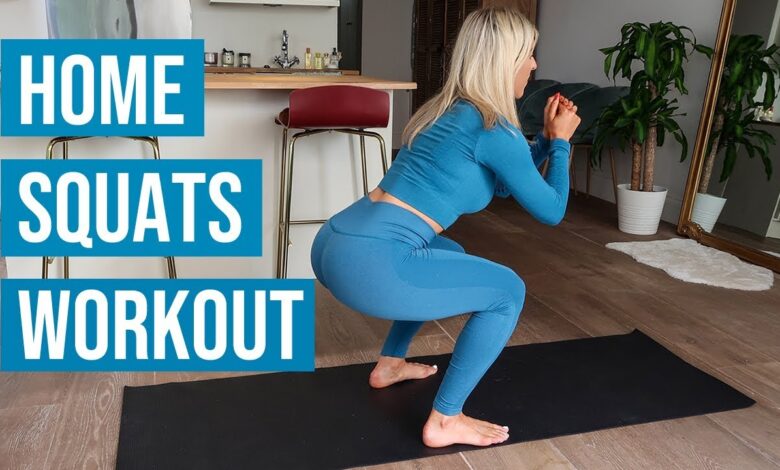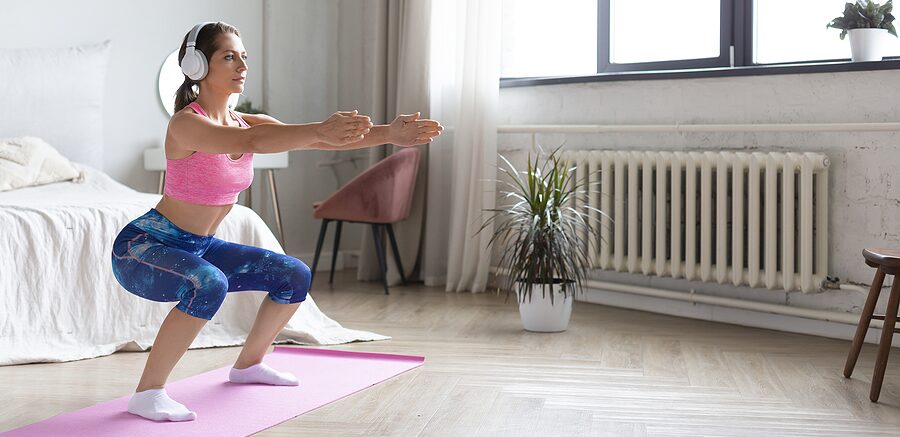Powerful Secrets: How to Do Squats at Home

How to Do Squats at Home for Beginners
Discover powerful secrets for how to do squats at home. Transform your routine with these expert tips now.
.Introduction
Are you tired of feeling like a couch potato but intimidated by the gym? Don’t fret! The solution to your fitness woes might be simpler than you think. Enter the humble squat – a powerhouse exercise that can transform your body and boost your confidence, all from the comfort of your own home.
Squats are the unsung heroes of the fitness world. They work multiple muscle groups simultaneously, improve balance, and can even make everyday activities easier. But for beginners, the idea of doing squats correctly can seem daunting.
What if you’re doing it wrong? What if you hurt yourself? These fears often hold people back from reaping the incredible benefits of this fundamental exercise.
Fear not! to know how to do squats at home, We’re here to guide you through the ins and outs of squatting at home. From understanding the basics to mastering various techniques, this comprehensive guide will take you from squat novice to home workout pro. So, are you ready to embark on your squat journey? Let’s dive into the world of home squats and discover how this simple exercise can revolutionize your fitness routine!

.Understanding the Basics of Squats
Squats are a foundational exercise that offer numerous benefits for your overall fitness:
- Full-body workout
- Improved lower body strength
- Enhanced core stability
- Increased calorie burn
- Better balance and coordination
Proper squat form and technique
Mastering proper squat form is crucial for maximizing benefits and preventing injuries:
- Stand with feet shoulder-width apart
- Keep chest up and shoulders back
- Lower your body as if sitting back into a chair
- Keep knees in line with toes
- Descend until thighs are parallel to the ground
- Push through heels to return to starting position
| Phase | Key Points |
|---|---|
| Setup | Feet shoulder-width, chest up |
| Descent | Sit back, knees track toes |
| Bottom | Thighs parallel to ground |
| Ascent | Push through heels, maintain form |
Common mistakes to avoid
Be aware of these common squat mistakes to ensure safe and effective workouts:
- Knees caving inward
- Rounding the back
- Lifting heels off the ground
- Not going deep enough
- Looking down instead of forward
Now that we’ve covered the basics of squats, let’s move on to setting up your home workout space for optimal squatting performance. how to do squats at home
Table of Contents
.Setting Up Your Home Workout Space how to do squats at home
Now that we understand the basics of squats, let’s focus on creating the perfect environment for your home squat routine.

A. Choosing the right area
Selecting an appropriate space for your squats is crucial for safety and effectiveness. Look for:
- A flat, non-slippery surface
- Sufficient ceiling height (at least 1-2 feet above your raised arms)
- Adequate room to move freely (about 6×6 feet)
B. Essential equipment for home squats
While bodyweight squats require no equipment, having a few items can enhance your workout:
| Equipment | Purpose |
|---|---|
| Yoga mat | Provides cushioning and grip |
| Full-length mirror | Helps check form |
| Resistance bands | Adds variety and intensity |
| Water bottle | Keeps you hydrated |
C. Safety considerations
Prioritize safety to prevent injuries and maximize results:
- Clear the area of obstacles
- Ensure good lighting
- Keep a towel nearby to wipe sweat
- Have your phone within reach for emergencies
By setting up a dedicated and safe space, you’re laying the foundation for a successful home squat routine. Next, we’ll explore essential warm-up exercises to prepare your body for effective squatting.
.Warm-Up Exercises for Effective Squatting
Now that you’ve set up your home workout space, it’s time to prepare your body for squatting. A proper warm-up is crucial for maximizing your squat performance and minimizing the risk of injury. how to do squats at home Let’s dive into three essential components of an effective squat warm-up routine. tips to fix your Brocken Relationship
Dynamic Stretches for Lower Body
Dynamic stretches help improve flexibility and increase blood flow to your muscles. Here are some key exercises to include:
- Leg swings (front to back and side to side)
- Walking lunges with a twist
- Knee hugs
- Butt kicks
Mobility Drills for Hips and Ankles
Improving hip and ankle mobility is crucial for maintaining proper form during squats. Try these drills:
- Hip circles
- Deep squat holds
- Ankle rotations
- Calf raises
Light Cardio to Increase Heart Rate
A brief cardio session will elevate your heart rate and further warm up your muscles. Choose from these options:
| Exercise | Duration | Intensity |
|---|---|---|
| Jumping jacks | 1-2 minutes | Moderate |
| High knees | 30-60 seconds | High |
| Jogging in place | 2-3 minutes | Low to moderate |
Remember to start slowly and gradually increase intensity. This warm-up routine should take about 5-10 minutes, how to do squats at home preparing you for an effective squat session. Next, we’ll explore the proper technique for mastering the bodyweight squat.
Mastering the Bodyweight Squat
Step-by-step guide to perfect form
Performing a bodyweight squat with proper form is crucial for maximizing benefits and preventing injuries. Follow these steps:
- Stand with feet shoulder-width apart
- Point toes slightly outward
- Engage core muscles
- Begin descent by pushing hips back
- Lower body as if sitting into a chair
- Keep chest up and shoulders back
- Ensure knees track over toes
- Descend until thighs are parallel to the ground
- Push through heels to return to starting position
Breathing techniques during squats
Proper breathing enhances stability and power during squats:
- Inhale deeply as you lower into the squat
- Exhale forcefully as you push back up
- Maintain a braced core throughout the movement
Modifications for beginners
| Modification | Description | Benefit |
|---|---|---|
| Wall squat | Perform squat with back against wall | Improves form and balance |
| Box squat | Lower onto a chair or box | Builds confidence and depth |
| Assisted squat | Hold onto a stable object for support | Enhances stability and range of motion |
Progressions to increase difficulty
As you gain strength and confidence, try these progressions:
- Increase rep count or sets
- Add pause at bottom of squat
- Perform single-leg squats
- Incorporate jump squats for explosiveness
Remember, on how to do squats at home consistency is key. Practice regularly to master the bodyweight squat and reap its full benefits. how to do squats at home, With proper form and gradual progression, you’ll build strength, improve mobility, and lay a solid foundation for more advanced exercises.
Variations to Spice Up Your Squat Routine
Now that you’ve mastered the basic bodyweight squat, it’s time to add some variety to your routine. These squat variations will target different muscle groups and keep your workouts engaging and challenging.
A. Sumo squats for inner thighs
Sumo squats are excellent for targeting your inner thighs and glutes. To perform this variation:
- Stand with your feet wider than shoulder-width apart, toes pointed outward
- Lower your body, keeping your back straight and chest up
- Push through your heels to return to the starting position
B. Jump squats for cardio boost
Jump squats combine strength training with cardio, making them perfect for burning calories and improving explosiveness:
- Start in a regular squat position
- As you come up, explode into a jump
- Land softly and immediately lower into the next squat
C. Wall sits for endurance
Wall sits are a static exercise that builds endurance in your quads and glutes:
- Lean against a wall with your feet shoulder-width apart
- Slide down until your thighs are parallel to the ground
- Hold this position for 30-60 seconds
D. Single-leg squats for balance
Single-leg squats, or pistol squats, challenge your balance and strengthen each leg individually:
- Stand on one leg, extending the other leg in front of you
- Lower your body as far as you can while maintaining balance
- Push through your heel to return to the starting position
| Variation | Primary Muscles Targeted | Additional Benefits |
|---|---|---|
| Sumo Squats | Inner thighs, glutes | Hip mobility |
| Jump Squats | Quads, glutes, calves | Cardiovascular endurance |
| Wall Sits | Quads, glutes | Static strength |
| Single-leg Squats | Quads, glutes, stabilizers | Balance, coordination |
how to do squats at home, check this how to do squats at home and Incorporating these variations into your routine will help you progress and prevent boredom. Next, we’ll look at how to create a beginner-friendly squat workout using these variations.

Creating a Beginner-Friendly Squat Workout
Now that you’ve mastered the basic squat technique, it’s time to create a workout routine that will help you build strength and endurance. Let’s explore how to structure your squat workout for optimal results.
Determining the right number of sets and reps
For beginners, it’s crucial to start with a manageable workload. Here’s a recommended structure:
- 3 sets of 8-12 repetitions
- Focus on proper form rather than quantity
As you progress, you can adjust the sets and reps based on your goals:
| Goal | Sets | Reps |
|---|---|---|
| Endurance | 2-3 | 15-20 |
| Strength | 3-5 | 6-8 |
| Muscle growth | 3-4 | 8-12 |
Incorporating rest periods
Rest is essential for muscle recovery and preventing fatigue. Follow these guidelines:
- Between sets: 60-90 seconds
- Between exercises: 2-3 minutes
- Listen to your body and adjust as needed
Progressive overload for continuous improvement
To keep challenging your muscles and making progress, implement progressive overload:
- Gradually increase the number of reps
- Add more sets to your routine
- Decrease rest time between sets
- Incorporate squat variations (e.g., jump squats, Bulgarian split squats)
Remember, consistency is key. Aim to perform your squat workout 2-3 times a week, allowing for adequate recovery between sessions. In the next section, we’ll discuss essential recovery techniques and post-squat care to maximize your results and prevent injury.
Recovery and Post-Squat Care
On how to do squats at home, Now that you’ve mastered the squat technique and completed your workout, it’s crucial to focus on recovery and post-squat care. how to do squats at home, This will help prevent soreness, reduce injury risk, and maximize your gains.
Proper cool-down exercises
Cooling down after your squat session is essential for gradually bringing your heart rate back to normal and preventing blood pooling in your legs. Here are some effective cool-down exercises:
- Light jogging or marching in place (2-3 minutes)
- Gentle walking (3-5 minutes)
- Slow bodyweight squats (10-15 repetitions)
Stretches to prevent soreness
Stretching helps improve flexibility and reduces muscle tension. Incorporate these stretches into your post-squat routine:
| Stretch | Duration | Target Area |
|---|---|---|
| Standing quadriceps stretch | 30 seconds per leg | Front thighs |
| Seated hamstring stretch | 30 seconds per leg | Back of thighs |
| Standing calf stretch | 30 seconds per leg | Calves |
| Hip flexor lunge stretch | 30 seconds per side | Hip flexors |
Nutrition tips for muscle recovery
Proper nutrition is crucial for muscle recovery and growth. Consider these tips:
- Consume protein within 30 minutes post-workout (20-30 grams)
- Replenish glycogen stores with complex carbohydrates
- Stay hydrated by drinking plenty of water
- Include anti-inflammatory foods like berries and leafy greens in your diet
By following these recovery and post-squat care strategies, you’ll be well-prepared for your next squat session and continue making progress in your fitness journey.
CONCLUSION
Squats are a fundamental exercise that can transform your fitness routine, even when performed at home. By understanding the basics, setting up a safe workout space, and mastering proper form, you can unlock the numerous benefits of this powerful movement. Remember to start with bodyweight squats, gradually progressing to variations as you build strength and confidence.
Incorporating squats into your regular workout routine can lead to improved lower body strength, enhanced core stability, and better overall fitness. how to do squats at home; Whether you’re a beginner or looking to refine your technique, the key is consistency and proper form.
how to do squats at home; Listen to your body, focus on recovery, and enjoy the journey towards a stronger, more resilient you. Start your squat journey today and experience the transformative power of this simple yet effective exercise.




